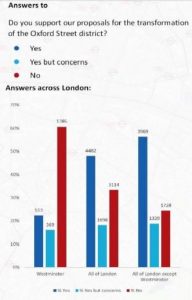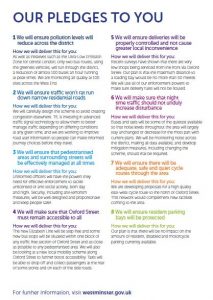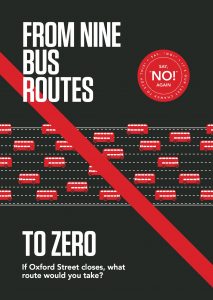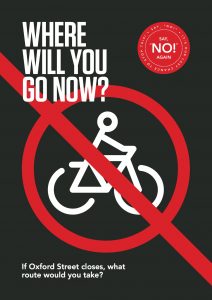66% – of Local Residents opposed/concerned – Why are they being ignored?
76% – of Businesses opposed/concerned – Why are they being ignored?
The Mayor plans to close Oxford Street to ALL traffic. For 24 hours a day.
In his manifesto Sadiq Khan said he would:- “Work with Westminster Council, local businesses, Transport for London (TfL) and taxis, to pedestrianise Oxford Street. I will start by bringing back car-free days, and possibly weekends, before moving towards full pedestrianisation. Our eventual ambition should be to turn one of the world’s most polluted streets into one of the world’s finest public spaces – a tree-lined avenue from Tottenham Court Road to Marble Arch.”
He has also stressed that this should only be done if there is no detriment to surrounding residential areas.
Despite the results of the first consultation, this gradual development has now turned into a headlong rush to pedestrianise the street all day, every day, with no solutions to the damage threatening residents and businesses or to the myriad accessibility issues.
Elsewhere, the world’s major cities give attention to traffic calming and pollution reduction in their residential areas, directing traffic to the major commercial roads. Even here in London, the “Mini-Holland” schemes to be found in outer London do the same. But with Oxford Street, Mayor Sadiq Khan wants to do the opposite: remove the traffic from one of central London’s few major east-west routes and push all the traffic, the congestion and pollution into the surrounding residential areas. Areas that already have major problems with too many vehicles and pollution levels way above EU recommended safe levels.
What sort of reality does the Mayor live in where he thinks that all this traffic should be taken out of an almost 100 per cent commercial area and pushed through its surrounding residential streets? Shifting congestion, pollution and road safety issues rather than tackling them is unacceptable. The scheme also creates a public realm management challenge at a time when there is no budget to tackle enforcement issues of antisocial behaviour. Westminster Council currently struggle to manage the existing public realm in Leicester Square and Trafalgar Square, Oxford Street would a free for all, for buskers, illegal street traders and other forms of antisocial behaviour.
And why hasn’t he listened to the message that came through loud and clear from residents and small businesses, schools, hospitals and many of the area’s stakeholders from the first consultation?
The majority of those that live and have businesses in the West End are against this scheme* – if this had been a referendum it would have been thrown out then. Instead it is being pushed through to the detriment of the wider West End. The people who know the area, who know the consequences of these hasty and ill thought out proposals, don’t want it.
THE PROPOSALS
This consultation is fuelled by many untested and unevidenced assumptions:
- That “transformation” of Oxford Street can only be achieved by full closure.
- That pollution in Oxford Street can only be solved by full closure.
- That footfall on Oxford Street is increasing, whereas the figures show that it is declining.**
- That pedestrianisation will increase the footfall and the retail take.
- That Crossrail will result in huge extra numbers in Oxford Street.***.
- That users of Oxford Street, particularly those older and disabled, those that work there, indeed those that shop there, do not want to be able to get a bus there.
- That traffic, once Oxford Street is closed, will simply evaporate and not run though the streets nearby.
- That businesses actually want it, whereas many will have huge problems in getting goods to their stores.
- That the huge amount of additional enforcement that will be vital in the wake of pedestrianisation, particularity through the night, will actually happen.
- That residents will not be affected by all the shops and businesses having to be serviced from the small streets surrounding Oxford Street.
- That these proposals can be pushed through without significantly affecting other existing and approved major road alterations including the Baker Street Two Way Project and, the Tottenham Court Road Scheme, which already will be removing significant road capacity.
THE CONSEQUENCES FOR SURROUNDING AREAS
The proposals as currently set out will have the following consequences for the surrounding areas:
On TfL’s current figures approximately 350 buses (hybrid/diesel engined) will run through Marylebone, each day and through the night, complete with bus stops where there is no room for them and idling areas where there is no space for them. The rest of the well established east-west bus routes are to be either curtailed or diverted at considerable disadvantage to the many passengers who rely on the current routes to and through Oxford Street.****
All other traffic will be displaced through surrounding local neighbourhoods of Marylebone, Fitzrovia, Mayfair and Soho. That includes: vans, lorries, taxis and pedicabs. After 7.00pm it also includes not only all the taxis but all the private vehicles and non black cab traffic that fill Oxford Street through the night. It means that all Oxford Street shops, stores and offices will need to be supplied and serviced through the surrounding residential streets. And we are told that this will improve the wider area!
THE BENEFITS TO OXFORD STREET
During the day Oxford Street will be open to amplified buskers, traders, pavement artists, clowns, jugglers and beggars; such as we already see in other pedestrianised areas in Leicester Square and Trafalgar Square.
Westminster Council has neither the funding nor the will to control those relatively small areas. What chance is there that they will be able to police a mile of pedestrianised road?
The only “transformation” will be to a higher level of tackiness than can be presently imagined.
The scheme, as has been acknowledged, will increase the likelihood of terrorist hostile vehicle attacks, as recently seen here and in other cities. The proposed way to stop this is to have vehicle safety barriers at all junctions crossing Oxford Street, unsightly, ungainly and of course a major problem for any vehicle access, from emergency services to road cleaning.
At night things will be even worse with an extremely long, empty un-patrolled street open to roaming gangs and the sort of anti-social and illegal behaviour that the police and the council find difficult to control even under the present conditions of easy access.
THE COSTS
Finally, not only do these proposals threaten to severely damage and undermine some of London’s finest historic conservation areas, and to do so without any good reason, but they are extremely expensive. TfL estimate they will spend in the region of £60 million to implement full closure, with an ongoing servicing obligation of many million pounds a year.
Transformation of Oxford Street? More like mutilation of the areas surrounding Oxford Street.
Reduce the pollution in Oxford Street by reducing buses and emissions NOT by pushing it all through the surrounding areas.
For interviews or more information contact communications via: contact@betteroxfordstreet
Notes for Editors
Better Oxford Street – is a campaign for a better Oxford Street, not a closed Oxford Street
Better Oxford Street is a not for profit residents and business group formed and supported by The Marylebone Association, the Fitzrovia Neighbourhood Association, Charlotte Street Association, Mayfair Residents Group, Residents’ Society of Mayfair and St James’s, all members of the West End Community Network. The area covered has a total residential population of approximately 42,000 and circa 470,000 business employees.
Better Oxford Street, 229 Great Portland Street, London, W1W 5PN Web www.betteroxfordstreet.org Email contact@betteroxfordstreet.org Twitter@BetterOxfordSt
Notes/Sources
*48 per cent of local residents are unequivocally against, 18% have concerns only 29 per cent support the proposals put forward by Mayor Sadiq Khan and pushed for by campaign group Living Streets. Residents say they are strongly against buses being diverted along parallel roads and taxi ranks being placed in side streets.
Businesses are even more opposed to the scheme: 60 percent are unequivocally against, a further 16 percent with concerns, and only 19 percent are fully in favour of the scheme. This figure puts most businesses at odds with the New West End Company which is in favour of the proposal albeit with some reservations.
Nearly 50 percent of all respondents either oppose or have concerns about the proposals and only 43 percent support the transformation of Oxford Street and are comfortable with the changes that would be necessary to make it possible, according to the consultation report.
So only 29% of local residents and 19% of businesses owners actually supported “transformation” without reservations.
Source: TfL Consultation Report September 2017 page 28
** “Footfall is in decline, particularly in the western section of the street.” – New West End Company
Source:- New West End Company’s response to the WCC/TfL consultation on the transformation of Oxford Street June 2017 https://newwestend.com/wp-content/uploads/2017/08/170811_Oxford-street_NWEC-response-to-consultation.pdf
*** In 2007 160 million passengers used the four Oxford Street tube stations.
In 2015 161 million passengers used the four Oxford Street tube stations.
A 0.1% rise in passengers meanwhile London’s population grew 13% over the same period. London growth does not translate into increased journeys into Oxford Street.
Source: Marble Arch, Bond Street, Oxford Circus, Tottenham Court Road Station entry/exit data from TfL
****London Buses propose removing most existing west/east bus routes to Marble Arch or Oxford Circus. The existing bus route network that runs along Oxford Street has 8 routes at 75 buses per hour. This will be slashed to 2 routes, the 139 and 390 which will be diverted along Wigmore Street at 18 buses per hour day time and night services of 8 buses per hour. This will curtail a well established bus route network, with easy access/interchange- for the many users who cannot use the tube network. The 2 diverted routes are not easily accessible to Oxford Street, and make it hard to get to interchanges between bus routes – at Marble Arch/Park Lane. This will disadvantage many, but again particularly those vulnerable passengers, the elderly and disabled who will no longer find these routes viable.






